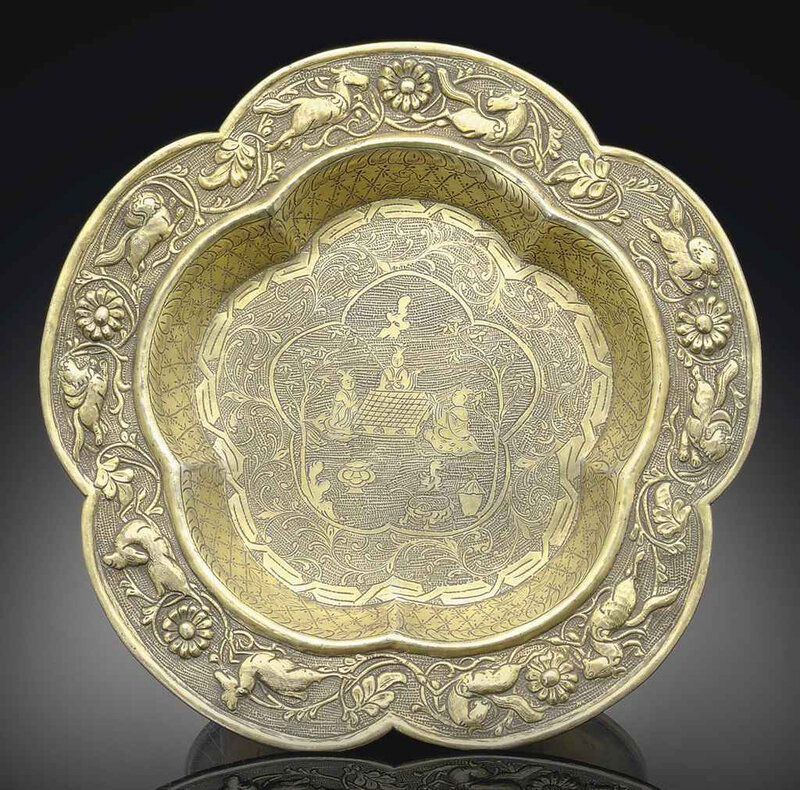Christie's. Fine Chinese Ceramics and Works of Art Part I and Part II Including Property from the Arthur M. Sackler Collections, 24 March 2011, New York, Rockefeller Plaza
A rare silver-gilt flower-form tazza, Liao-Song dynasty, 10th-12th century
Lot 1275. A rare silver-gilt flower-form tazza, Liao-Song dynasty, 10th-12th century; 6 7/8 in. (17.5 cm.) across. Estimate $15,000 - USD 20,000. Price Realized $32,500. © Christie's Images Ltd 2011.
The pentafoil dish raised on a spreading pedestal foot, the interior engraved with a scene of two men playing weiqi while a third observes in a garden setting surrounded by foliate scroll reserved on a ring-punched ground within a border of geometric key fret, below birds reserved on a diamond-pattern ground bordered by a band of overlapping petals in the well, the everted rim chased with pairs of animals racing amidst chrysanthemum scroll bearing large blossoms that center each pair, box.
Provenance: Acquired by Walter Hochstadter prior to 1997 and gifted to Alice Chu, Mr. Hochstadter's companion in Australia, and thence by descent to the present owner.
Note: The decoration of this tazza is quite unusual, i.e., the combination of the figural scene in the center and the band of racing animals on the rim, which is reminiscent of decoration found on Tang mirrors, where animals race amidst grapevine. The scene of the weiqi players can also be found on a silver-gilt jar and cover excavated in 1987 from the crypt of the Famen Temple, Fugeng county, Shaanxi province, illustrated by C. Michaelson, Gilded Dragons: Buried Treasures from China's Golden Ages, British Museum, 1999, pp. 157-8, no. 114. As with the scene on the tazza, there is an onlooker seated behind the table and all are surrounded by a garden setting. The scene is one of four figural scenes decorating the sides of the jar.
See, also, the plain silver dish dated to the 12th century, which has a similar wide everted rim divided into six rather than five lobes above a similarly lobed and canted well on the interior, illustrated by J. Rawson, The British Museum Book of Chinese Art, London, 1992, p. 218, fig. 159.
A Technical Examination Report is available upon request.

/https%3A%2F%2Fprofilepics.canalblog.com%2Fprofilepics%2F1%2F0%2F100183.jpg)
/https%3A%2F%2Fstorage.canalblog.com%2F03%2F02%2F119589%2F96711876_o.jpg)
/https%3A%2F%2Fstorage.canalblog.com%2F11%2F31%2F119589%2F94773502_o.jpg)
/https%3A%2F%2Fstorage.canalblog.com%2F20%2F83%2F119589%2F94772815_o.jpg)
/https%3A%2F%2Fstorage.canalblog.com%2F26%2F72%2F119589%2F75604929_o.jpg)
/https%3A%2F%2Fstorage.canalblog.com%2F59%2F60%2F119589%2F26458628_o.jpg)



/image%2F1371349%2F20240313%2Fob_442224_73f852fd-0080-47e0-8201-43c48aac58fa.jpg)
/http%3A%2F%2Fstorage.canalblog.com%2F02%2F69%2F119589%2F128357833_o.jpg)
/http%3A%2F%2Fstorage.canalblog.com%2F39%2F61%2F119589%2F128357725_o.jpg)
/http%3A%2F%2Fstorage.canalblog.com%2F19%2F94%2F119589%2F128220486_o.jpg)